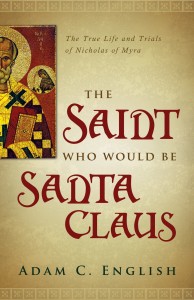Naughty or nice?
Yep, you’ve been both this year. You’ve been nice because it’s the right thing to do, it gives you a warm-fuzzy, and you want to make the world a better place.
You’ve been naughty because it’s fun.
You’ve been both, but not because of some fat guy in a red suit. You stopped believing in Santa years ago, but read the new book The Saint Who Would Be Santa Claus by Adam C. English, and you might change your mind.
You know him as Santa Claus. He also goes by Sinterklaas, Kriss Kringle, Père Noël, and Father Christmas and he, in his familiar jolly-old-elf incarnation, has been around about 100 years. Santa-as-gifter is a few centuries older than that, but the real Santa showed up some 1750 years ago.
His name was Nicholas and he was born in the ancient Mediterranean city of Patara sometime after the year 260, according to an eighth-century biographer. The biographer, like most literate people of his time, was given to florid language (straightforward prose, says English, was “gauche and uncouth”) and facts were “disdained,” so it’s no surprise that Nicholas’ story is filled with fanciful miracles and other phenomena.
Nicholas was, by any account, loved by his upper-class family. He was well-educated and was given a solid religious base on which to grow. The latter allowed him “remarkable signs of spiritual maturity at a young age,” and he was ordained a priest at age nineteen, about a year after having lost both his parents in a plague.
Nicholas was known as a great lover of children, and his generosity is legendary. The main story attributed to him involves the dowries of three destitute sisters bound for prostitution. On three successive nights, Nicholas threw money in their father’s window, to save the girls – possibly his earliest gift. He took his ministry seriously, and his kindness was widely known throughout Europe .
Nicholas died at around age 70.
Through the centuries, because of miracles and anecdotes connected to him, Nicholas became the patron saint of pawnbrokers, newlyweds, bankers, voyagers, firemen, and pilgrims and others. And he’s beloved by generations of children who know him by a different name…
The Saint Who Would Be Santa Claus is steeped in ancient history, Biblical teachings, legend, and Roman society. It’s sweeping in depth and intelligence. That gives it an interesting flair that teeters on the sometimes-not-so-interesting.
Author Adam C. English starts with modern pop culture and quickly gets to the nitty-gritty of Santa’s roots. He then dives into pagan and Christian history, and pulls us out with a centuries-long story of a saint who some doubt ever existed before plunging back into fourth century Rome . That back-and-forth sometimes kept my attention, but was more often too much for me to follow.
Still, I think Biblical scholars will enjoy this book more than I did, and if that’s you, or if you’re very interested in ancient history, ask for it. The Saint Who Would Be Santa Claus might be a gift that’s nice.
The Saint Who Would Be Santa Claus by Adam C. English (Baylor University Press, $24.95, 245 pages)





